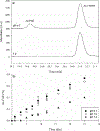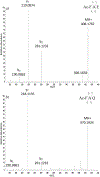Spontaneous Cleavage at Glu and Gln Residues in Long-Lived Proteins
- PMID: 34677941
- PMCID: PMC9206231
- DOI: 10.1021/acschembio.1c00379
Spontaneous Cleavage at Glu and Gln Residues in Long-Lived Proteins
Abstract
Long-lived proteins (LLPs) are prone to deterioration with time, and one prominent breakdown process is the scission of peptide bonds. These cleavages can either be enzymatic or spontaneous. In this study, human lens proteins were examined and many were found to have been cleaved on the C-terminal side of Glu and Gln residues. Such cleavages could be reproduced experimentally by in vitro incubation of Glu- or Gln-containing peptides at physiological pHs. Spontaneous cleavage was dependent on pH and amino acid sequence. These model peptide studies suggested that the mechanism involves a cyclic intermediate and is therefore analogous to that characterized for cleavage of peptide bonds adjacent to Asp and Asn residues. An increased amount of some Glu/Gln cleaved peptides in the insoluble fraction of human lenses suggests that cleavage may act to destabilize proteins. Spontaneous cleavage at Glu and Gln, as well as recently described cross-linking at these residues, can therefore be added to the similar processes affecting long-lived proteins that have already been documented for Asn and Asp residues.
Conflict of interest statement
Figures






Similar articles
-
Mechanism of protein cleavage at asparagine leading to protein-protein cross-links.Biochem J. 2019 Dec 23;476(24):3817-3834. doi: 10.1042/BCJ20190743. Biochem J. 2019. PMID: 31794011 Free PMC article.
-
Spontaneous protein-protein crosslinking at glutamine and glutamic acid residues in long-lived proteins.Biochem J. 2021 Jan 29;478(2):327-339. doi: 10.1042/BCJ20200798. Biochem J. 2021. PMID: 33345277 Free PMC article.
-
Age-related cleavages of crystallins in human lens cortical fiber cells generate a plethora of endogenous peptides and high molecular weight complexes.Proteins. 2015 Oct;83(10):1878-86. doi: 10.1002/prot.24872. Epub 2015 Aug 19. Proteins. 2015. PMID: 26238763
-
Isomerization of aspartyl residues in crystallins and its influence upon cataract.Biochim Biophys Acta. 2016 Jan;1860(1 Pt B):183-91. doi: 10.1016/j.bbagen.2015.08.001. Epub 2015 Aug 12. Biochim Biophys Acta. 2016. PMID: 26275494 Review.
-
Collision-induced fragmentations of the (M-H)- parent anions of underivatized peptides: an aid to structure determination and some unusual negative ion cleavages.Mass Spectrom Rev. 2002 Mar-Apr;21(2):87-107. doi: 10.1002/mas.10022. Mass Spectrom Rev. 2002. PMID: 12373746 Review.
Cited by
-
Stability of Protein Pharmaceuticals: Recent Advances.Pharm Res. 2024 Jul;41(7):1301-1367. doi: 10.1007/s11095-024-03726-x. Epub 2024 Jun 27. Pharm Res. 2024. PMID: 38937372 Review.
-
Genesis and regulation of C-terminal cyclic imides from protein damage.Proc Natl Acad Sci U S A. 2025 Jan 7;122(1):e2415976121. doi: 10.1073/pnas.2415976121. Epub 2024 Dec 30. Proc Natl Acad Sci U S A. 2025. PMID: 39793072 Free PMC article.
-
Eye lens β-crystallins are predicted by native ion mobility-mass spectrometry and computations to form compact higher-ordered heterooligomers.Structure. 2023 Sep 7;31(9):1052-1064.e3. doi: 10.1016/j.str.2023.06.013. Epub 2023 Jul 14. Structure. 2023. PMID: 37453416 Free PMC article.
-
Progesterone inhibits endometrial cancer growth by inhibiting glutamine metabolism through ASCT2.Biosci Rep. 2024 Mar 29;44(3):BSR20232035. doi: 10.1042/BSR20232035. Biosci Rep. 2024. PMID: 38415405 Free PMC article.
-
Isotopic Composition of C, N, and S as an Indicator of Endometrial Cancer.Cancers (Basel). 2024 Sep 16;16(18):3169. doi: 10.3390/cancers16183169. Cancers (Basel). 2024. PMID: 39335141 Free PMC article.
References
-
- Truscott RJW, Long-Lived Cells and Long-Lived Proteins in the Human Body, in Long-lived Proteins in Human Aging and Disease. 2021. p. 5–42.
Publication types
MeSH terms
Substances
Grants and funding
LinkOut - more resources
Full Text Sources

